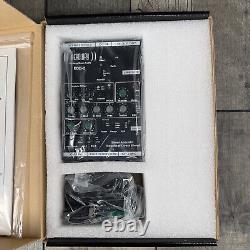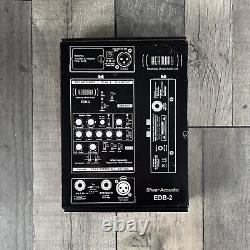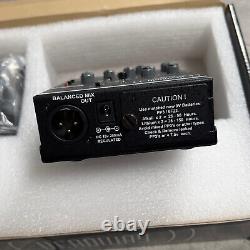
- Amp Power Supply
- Brand
- Model Type
- To Fit
- Type
- Charger (17)
- Circuit Board (12)
- Fire Alarms (26)
- Flyback Converter (30)
- Forward Converter (13)
- Hi-fi Amplifier (12)
- Inverters (17)
- Linear Power Supply (34)
- Miscellaneous (9)
- Power Amplifier (33)
- Power Module (10)
- Power Supply (455)
- Power Supply Unit (20)
- Pre Amplifier (11)
- Processor (26)
- Psu (10)
- Solar Controller (67)
- Switch (11)
- Tape Reel (18)
- Transformers (14)
- Other (2117)
- Unit Type
- Voltage
Headway EDB-2 Portable Acoustic Instrument Pre-amp New Old Stock







Headway EDB-2 Portable Acoustic Instrument Pre-amp New Old Stock. The channel 1 input is on a TRS jack and, as on the EDM1, gives you the option of sending 9V phantom power to ring or tip. Channel 2 is also fed by a TRS jack, but this allows you to access the channels separately: channel 1 on the tip and channel 2 on the ring (if you plug in a stereo jack), or just channel 2 if you use a mono jack. Additionally, the second channel can come from a balanced XLR microphone input, to which 18V of phantom power can be supplied, via a front-panel three-position switch that also enables you to cut out the microphone input to reduce background noise.
You also have the ability to reverse the polarity of either channel relative to the other. Both channels 1 and 2 have their own gain controls, plus individual input impedance selection (identical to that of the EDM1). The EQ is the same interactive Baxandall type, but this time the EDM1's three-band setup is joined by a high-mid band at 900Hz and a'presence' band at 2.8kHz. In addition, there's a semi-parametric, fixed-depth (-12dB) notch filter with variable width (five octaves to half an octave) and a range of 50Hz to 6kHz. The five-band EQ is always active and can be switched into either or both channels, whilst the notch filter, which has its own in/out switch and indicator LED, affects either channels 1 or 2, but not both together. The Range switch on the EDB2 is about the only function inherited from the original EDB1 that hasn't been upgraded or improved in some way.In contrast to the continuously variable cutoff found on the EDM1, the EDB2 retains the EDB1's three-position switch, giving you the choice of voicings for violin, guitar or bass. Fortunately, because the Bass EQ band is centred at 120Hz, setting up the EDB2 for instruments such as bouzouki, tenor guitar or viola isn't really going to be much of an issue, although duplicating the EDM1's Rock Acoustic setting is going to require a bit of creative use of both the EQ and notch filter.
Finally, it's worth mentioning two small tweaks that illustrate the thought that has gone into the EDB2. The first of these is an'iPod in' stereo mini-jack that allows you to send a mono sum of the output of your MP3 player of choice directly to the EDB2's outputs. The second, and an on-stage saviour for me, is the standby position on the power switch. Being able to switch power to the EDB1 on or off without causing major thumps and bangs through the PA is a real convenience.
